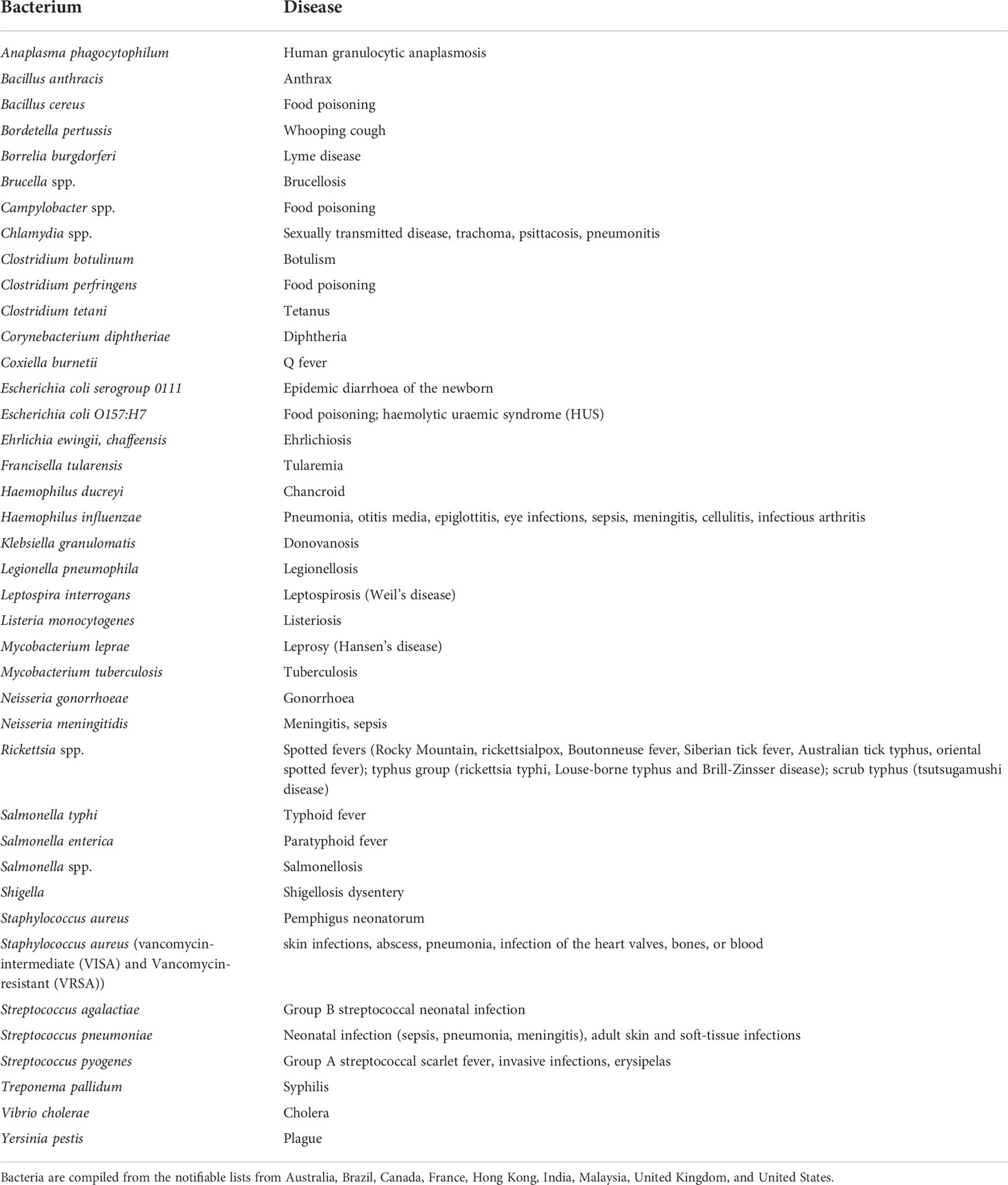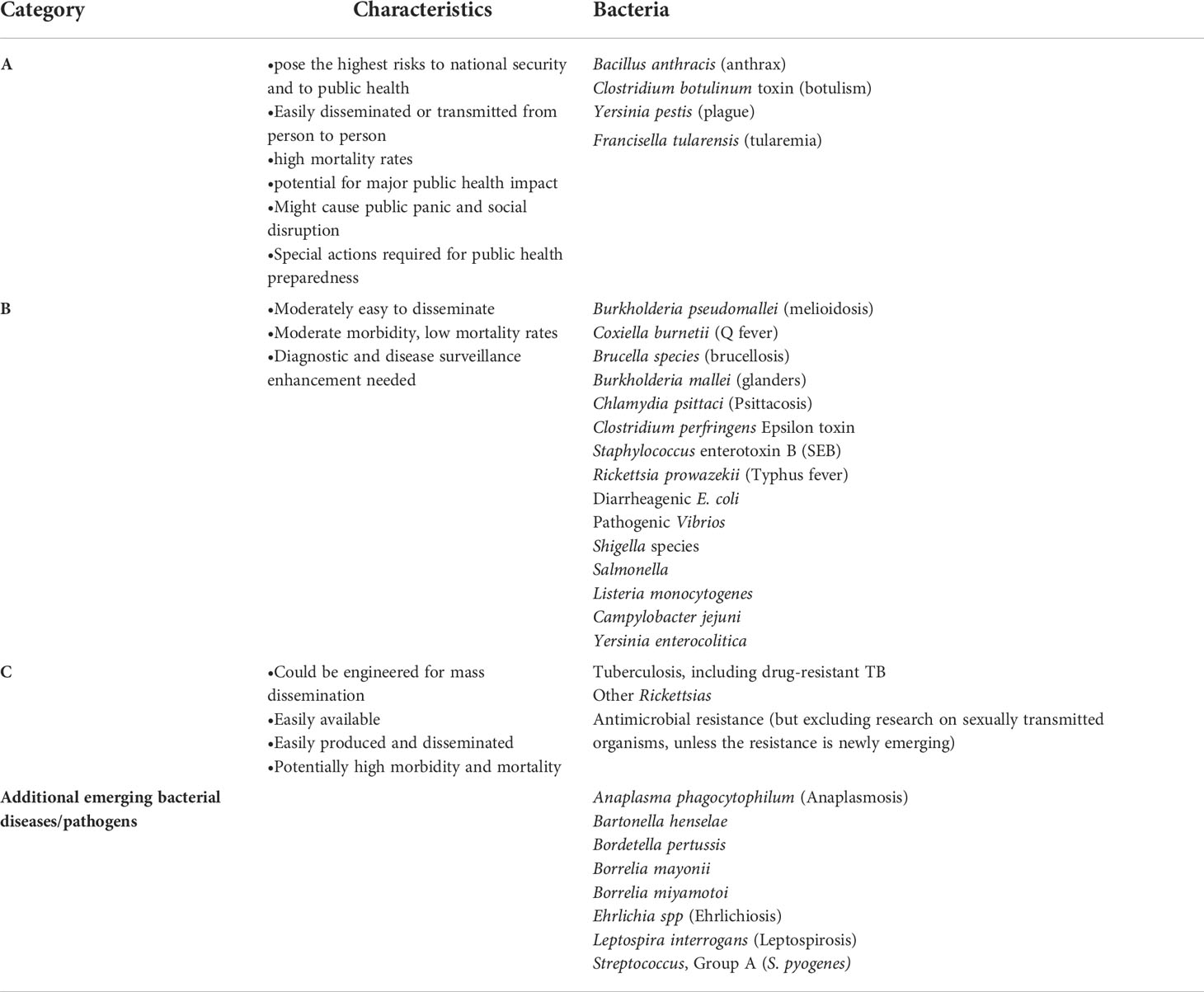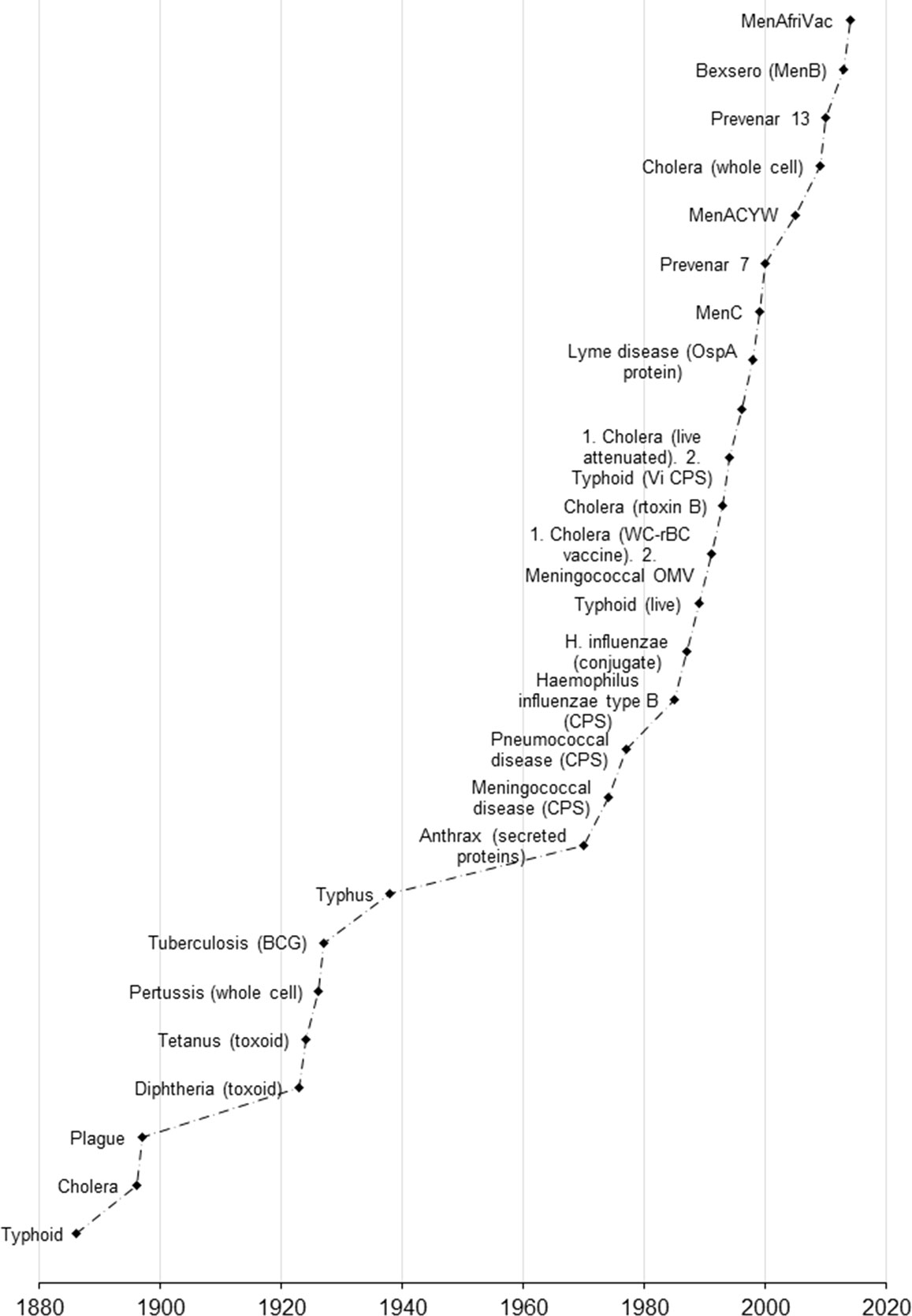- Neisseria Research Group, Molecular Microbiology, School of Clinical and Experimental Sciences, Faculty of Medicine, University of Southampton, Southampton, United Kingdom
Introduction
This specialty section covers pathogenesis, vaccines, and immunity to bacterial infections. All three focus areas are interconnected and understanding the mechanisms of bacterial pathogenicity and the immune response to infection informs the development of new vaccines and antimicrobials.
Bacterial pathogenesis
Bacteria are known to cause a huge number of different infections of humans and animals, ranging from asymptomatic to symptomatic to varying degrees. Infection occurs when a microorganism invades a host and multiplies on or in host tissues; multiplication can be contained at the site of infection, for example through granuloma formation, or disseminate and become fulminant. The consequences of infection to the host depend on the interplay between the pathogen and the host immune response, and this interplay can result in the disruption of normal cellular and organ homeostasis. This interplay can be relatively simple to understand, for example in toxin-mediated infections where toxin molecules can interact with host cell receptors and disrupt normal cellular hemostasis, leading to symptoms characteristic of the bacterial infection. These can range from simple released toxins to complicated type secretory systems that can deliver bacterial molecules directly into the host cell. Or the interplay can be more complex, for example infections that involve different life cycle stages, with bacteria moving from an extracellular existence to cellular invasion, immune avoidance, persistence, and dormancy (Wilson et al., 2019).
In this section, we encourage articles that seek to provide new insights into the varieties of human/animal-bacteria interactions, bacterial virulence – the measure of the pathogenicity of an organism - and new experimental vertebrate and invertebrate models of infection. Information about disease pathologies is also a critical need. New mechanisms of bacterial pathogenesis to be explored include survival in external environments, colonization (adherence, motility, chemotaxis, secretory systems, and biofilm formation), barrier penetration and invasion, nutrient acquisition, and evasion of innate immunity. Virulence regulation and genetic modification is also important, e.g. how bacteria acquire new virulence traits, and how genetic change and diversification is affected through mutation, phase and antigenic variation, and transformation. New developments in restriction-modification systems and the CRISPR-Cas systems of bacterial adaptive immunity (Barrangou et al., 2007) are also important for understanding pathogenesis and CRISPR interference could be used for functional analyses of specific genes in pathogens (Zhang et al., 2021). Other key challenges include the identification of bacterial virulence factors and host factors required for infection and models to measure them, including ex vivo cell and organ culture models, and animal transgenic models of infection and controlled human infection models (CHIMs). The latter are available for Streptococcus pneumoniae, S. pyogenes, Neisseria gonorrhoeae and N. lactamica, enterotoxigenic Escherichia coli (ETEC), Salmonella typhi, Vibrio cholerae and Mycobacterium tuberculosis (BCG surrogate) (Pollard et al., 2020). Identifying host factors required for infection, profiled using comparative genomics, transcriptomics, proteomics, and metabolomics is also needed for drug and vaccine development.
Developed countries and many middle-income countries have lists of notifiable bacterial diseases of humans and animals, which are required by law to be reported to government health authorities. Notifications are important to monitor the emergence of new diseases and/or vaccine-escape mutants and provide an ‘early warning system’ for epidemics and indeed pandemics. On a global level, the World Health Organization (WHO) no longer has a specific list for human pathogens (originally only restricted to cholera, plague and smallpox) and leaves notifications to member countries (Table 1). The World Organization for Animal Health, conversely, does monitor specific animal diseases globally and the important bacteria are shown in Table 2. It is fair to say that our understanding of how many of these pathogens cause disease is incomplete and a major obstacle to developing effective targeted treatments and prophylactic vaccines.
For this section, we also encourage research articles on emerging bacterial pathogens, which the National Institute of Allergy and Infectious Diseases (NIAID) classifies into three categories, whose membership are under continual review (https://www.niaid.nih.gov/research/emerging-infectious-diseases-pathogens). The NIAID defines emerging infectious diseases as those that have ‘newly appeared in a population or have existed but are rapidly increasing in incidence or geographic range’ and naturally many are of concern for biodefense reasons. The characteristics of the bacterial pathogens belonging to each category are shown in Table 3, and they are accompanied with an additional list of emerging infectious diseases/pathogens.
Bacterial vaccines
The history of the development of bacterial vaccines for animals and humans is a rich one (Plotkin and Plotkin, 2011). Figure 1 shows a timeline starting from the 1880s for the introduction of vaccines for major bacterial infections of humans. Many of these vaccines have made an enormous impact on reducing morbidity and mortality from bacterial infections over the past century. Vaccines such as the diphtheria, tetanus, and pertussis (DTP) triple vaccine, the many meningitis vaccines (HiB, meningococcal and pneumococcal) have helped to increase life expectancy by alleviating childhood mortality globally. Today, the WHO estimates that 2-3 million human deaths are prevented every year through immunization against diphtheria, tetanus and pertussis (and measles). Despite their success, global vaccination rates are still insufficient, and the WHO and United Nations International Children's Emergency Fund (UNICEF) also note that 23 million children missed out on basic vaccines through routine immunization services in 2020, a consequence of the COVID-19 pandemic. Reductions in vaccine uptake will impact on herd immunity and could lead to resurgent diseases. The challenge is not only to increase uptake of tried and tested vaccines, but also to develop vaccines for many still intractable bacterial infections and emerging and re-emerging pathogens (Williamson and Westlake, 2019). A complication for many infections is their zoonotic provenance and interrupting the life cycle of several important pathogens may require vaccines for both animals and humans. Zoonotic transmission of bacteria is important, and we encourage research articles into zoonotic infections, as our understanding of animals as reservoirs for emerging and re-emerging bacterial pathogens is wholly incomplete. Furthermore, the WHO priority list of bacteria with anti-microbial resistance contains many challenging organisms for whom no vaccines are currently licensed (Table 4). However, there are a total of 94 confirmed active preclinical candidates and a total of 61 vaccine candidates in active clinical development (WHO, 2022). Worryingly, pathogens rated as a critical or high priority (Table 4) tended to have fewer candidates in clinical development than the pathogens categorized as medium priority.
Historically, the development of important animal vaccines has tended to mirror the development of human vaccines. The major challenges in this sector are the need for new vaccines for zoonotic and chronic diseases of both domestic and companion animals, and a desire to move away from the overuse of antibiotics (Hoelzer et al., 2018a; Hoelzer et al., 2018b). Common technologies used for human and animal vaccine development include live-attenuated, inactivated (killed whole cell), toxoid, recombinant vaccines, glyco-conjugate and DNA/viral vector vaccines (Ghattas et al., 2021). Most of the newer viral-vector and DNA-based technologies have been used to develop vaccines for viral infections of animals (Aida et al., 2021), whereas bacterial vaccines have tended to be killed, live, avirulent and bacterin/toxoids. For example, interrogating the comprehensive list of veterinary vaccines licensed by the United States Department of Agriculture gives an idea of the types of licensed bacterial vaccines for animals (https://www.aphis.usda.gov/aphis/ourfocus/animalhealth/veterinary-biologics/ct_vblicensed_products) and also the many mixed vaccines (viral-bacterial) available (Supplementary Table 1). Given the crude nature of many of these bacterin vaccines, the challenge is to develop modern and more effective vaccines for agriculture, with less toxicity and better immunogenicity.
In this section, we encourage research articles on the broadest scope of human and animal vaccinology, which address many of the challenges we face. With the rapid introduction of the COVID-19 vaccines (underpinned of course by decades of funded pre-clinical studies to develop the platforms), are we entering a new age of vaccine development, with transferable technologies? The application of mRNA and adenoviral-vector based platforms for COVID-19 vaccines may see translation to bacterial vaccine development with defined antigens, though the apparent short-term humoral immunity that necessitates repeated vaccination against SARS-CoV2 may not be appealing for bacterial vaccines compared with more traditional approaches. Many challenges still remain for bacterial vaccines in the C21st: they include the need for 1) new state-of-the-art vaccine platforms; 2) a One Health approach to combat zoonoses; 3) new and safe adjuvant and delivery systems to enhance immunogenicity; 4) vaccines inducing mucosal immunity and obviating parenteral administration; 5) identifying vaccine antigens for pathogens, e.g. from in silico studies through to interrogating the proteome; 6) defining the immunological bases of protection against infection and determining correlates of protection; 7) developing vaccines for pathogens that have multiple serotypes and serogroups; even if target antigens are identified, these too may show hypervariability that necessitates developing multiple serotype vaccines to ensure broad coverage of circulating infective strains; and 8) testing vaccines in animal models to demonstrate protection and moving towards using human challenge models of infection for vaccine trials. Also, establishing the way science and government respond to the risk of bioterrorism with completely new pathogens is a real challenge.
Immunity to bacterial infections
The mammalian immune response is critical to understanding how bacterial infections develop and how they can be controlled using antimicrobials or prevented by vaccination. There are considerable knowledge gaps to our understanding of immunity to infection, and more knowledge is needed on how the host defends itself from bacterial infection, how the normal microbiota protects against pathogen occupation, and conversely how pathogens perturb the microbiota to establish colonization. What are the molecular and cellular processes that the skin and exposed mucosae of the gastrointestinal, urogenital, and respiratory tracts present as first lines of defense against infection? New in vitro and in vivo models are needed to study how pathogens breach barriers. In addition, new knowledge is needed on how pathogens interact with the innate immune system, how the latter recognizes pathogens and the molecular and cellular mechanisms involved in the interactions of immune effector cells in aiding pathogen clearance. A deeper understanding of the role of autophagy, complement and immune response mediators (e.g. cytokines and chemokines) in host defense is needed, and also how up- and dysregulated innate immune responses are deleterious to the host. Conversely, the ability of some pathogens to survive within immune cells and enter latency is a challenging biological phenomenon for the development of new vaccines.
We also need to better understand how the innate and adaptive immune responses to bacterial pathogens are linked. In this section, we encourage articles describing new findings on adaptive immune responses against bacterial infections, including how pathogens and antigens are processed and neutralized, and the increasingly important role of Th1/Th2/Th17 cell mediated immunity. Linking these together with the definition of correlates of protection is fundamental to the development of successful vaccines.
Conclusions
The ‘golden age of microbiology’, that period from the 1880 to 1920s, saw the discovery and first culture of many agents causing different infectious diseases, with notable bacteria including N. menigitidis and N. gonorrhoeae, H. influenzae, S. pneumoniae, S. pyogenes, S. agalactiae, S. aureus, L. monocytogenes, P. aeruginosa, Salmonella spp., Klebsiella, Escherichia, Treponema, Leptospira, M. tuberculosis (Christodoulides, 2013). The introduction of vaccines for many of these pathogens (Figure 1) and of antibiotics since the 1940s, have been two major factors that have helped increase life expectancy globally. Despite our success in controlling many of these major infections, there remain significant challenges for an increasingly interconnected and mobile global population, with the spectre of emerging diseases of concern. More investment into understanding how bacteria cause infections and on developing new vaccines and treatments is needed, to maintain the gains of the last century and to raise the quality of life for people living in the least developed and low-to-middle income countries. In this specialty section, our goal is to present our readership with articles of the highest quality on bacterial pathogenesis and virulence, immunity to infection and vaccines that will have positive impacts on global ill-health and inequalities.
Author contributions
The author confirms being the sole contributor of this work and has approved it for publication.
Conflict of interest
The author declares that the research was conducted in the absence of any commercial or financial relationship that could be construed as a potential conflict of interest.
Publisher’s note
All claims expressed in this article are solely those of the authors and do not necessarily represent those of their affiliated organizations, or those of the publisher, the editors and the reviewers. Any product that may be evaluated in this article, or claim that may be made by its manufacturer, is not guaranteed or endorsed by the publisher.
Supplementary material
The Supplementary Material for this article can be found online at: https://www.frontiersin.org/articles/10.3389/fbrio.2022.1049307/full#supplementary-material
References
Aida V., Pliasas V. C., Neasham P. J., North J. F., Mcwhorter K. L., Glover S. R., et al. (2021). Novel vaccine technologies in veterinary medicine: A herald to human medicine vaccines. Front. Vet. Sci. 8, 654289. doi: 10.3389/fvets.2021.654289
Barrangou R., Fremaux C., Deveau H., Richards M., Boyaval P., Moineau S., et al. (2007). CRISPR provides acquired resistance against viruses in prokaryotes. Science 315, 1709–1712. doi: 10.1126/science.1138140
Christodoulides M. (2013). “A history of bacterial meningitis from antiquity to modern times,” in Meningitis: cellular and molecular basis. Ed. Christodoulides M. (Wallingford, Oxfordshire: CABI), 1–16.
Ghattas M., Dwivedi G., Lavertu M., Alameh M. G. (2021). Vaccine technologies and platforms for infectious diseases: Current progress, challenges, and opportunities. Vaccines (Basel) 9:1–31. doi: 10.3390/vaccines9121490
Hoelzer K., Bielke L., Blake D. P., Cox E., Cutting S. M., Devriendt B., et al. (2018a). Vaccines as alternatives to antibiotics for food producing animals. part 1: challenges and needs. Veterinary Res. 49, 64. doi: 10.1186/s13567-018-0560-8
Hoelzer K., Bielke L., Blake D. P., Cox E., Cutting S. M., Devriendt B., et al. (2018b). Vaccines as alternatives to antibiotics for food producing animals. part 2: new approaches and potential solutions. Veterinary Res. 49, 70. doi: 10.1186/s13567-018-0561-7
Plotkin S. A., Plotkin S. L. (2011). The development of vaccines: How the past led to the future. Nat. Rev. Microbiol. 9, 889–893. doi: 10.1038/nrmicro2668
Pollard A. J., Sauerwein R., Baay M., Neels P., Balasingam S., Bejon P., et al. (2020). Third human challenge trial conference, Oxford, united kingdom, February 6–7, 2020, a meeting report. Biologicals 66, 41–52. doi: 10.1016/j.biologicals.2020.04.004
WHO (2022). Bacterial vaccines in clinical and preclinical development: an overview and analysis (Geneva: World health Organization). Licence: CC BY-NC-SA 3.0 IGO.
Williamson E. D., Westlake G. E. (2019). Vaccines for emerging pathogens: Prospects for licensure. Clin. Exp. Immunol. 198, 170–183. doi: 10.1111/cei.13284
Wilson B., Winkler M., Ho B. (2019). Bacterial pathogenesis: A molecular approach. 4th Edition (Portland, Oregon, USA: ASM Press).
Keywords: bacteriology, host-pathogen interactions, human and veterinary, drugs and antimicrobials, vaccines, clinical translation, animal and human challenge models
Citation: Christodoulides M (2022) Specialty grand challenge frontiers in bacteriology: Pathogenesis, vaccines, and immunity of bacterial infections. Front. Bacteriol. 1:1049307. doi: 10.3389/fbrio.2022.1049307
Received: 20 September 2022; Accepted: 07 October 2022;
Published: 20 October 2022.
Edited and Reviewed by:
Eleftherios Mylonakis, Brown University, United StatesCopyright © 2022 Christodoulides. This is an open-access article distributed under the terms of the Creative Commons Attribution License (CC BY). The use, distribution or reproduction in other forums is permitted, provided the original author(s) and the copyright owner(s) are credited and that the original publication in this journal is cited, in accordance with accepted academic practice. No use, distribution or reproduction is permitted which does not comply with these terms.
*Correspondence: Myron Christodoulides, bWM0QHNvdG9uLmFjLnVr
 Myron Christodoulides
Myron Christodoulides



